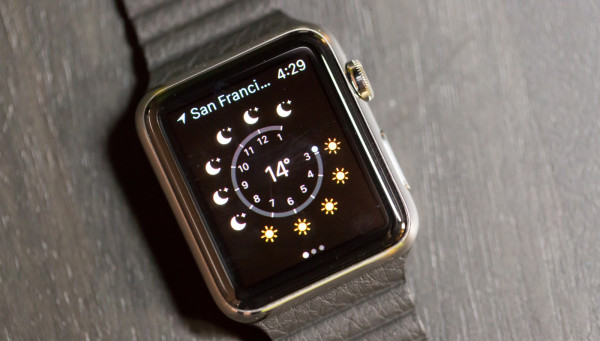As TechCrunch’s resident watch nerd, I have been asked many times if I’m swapping my Omegas and Seikos and JLCs for the Apple Watch.
And I have. I honestly have. I’ve worn the Apple Watch every day since I got it and I don’t know when I’m going to strap on a mechanical next. It’s the saddest thing in the world for me to say but, after years of calling each and every smartwatch nice but not necessary, I’ve finally succumbed to this shiny bauble for a number of reasons.
It gets notifications right
I’ve worn multiple Android Wear devices, as well as a Pebble. I’ve also seen other devices like Martian and Geak come and go and none of them did exactly what smartwatches are supposed to do: send me notifications that I can either act on or ignore. Pebble came closest to that goal (and I did pre-order the color Pebble because I love the company) but it lacked most of the features that make things like Samsung and Apple’s smartwatches superior — including workout monitoring and simple “apps.”
That said, why don’t I just wear a Fitbit and my Speedmaster? Because I think the Apple Watch does the best of both of those objects in a package that, in some ways, gives the Speedmaster a run for its money. It’s that simple.
It’s beautiful
I know how watches are built. I’ve repaired a few mechanicals, and I’ve visited a number of watch factories. I know for certain that there are a number of Swiss companies that are arguing over their Montrachet and claims about how Apple pulled it off. They have been able to build a steel case with curved sides and crystal for a price that comes in far below anything any Swiss house could offer.
Consider the much-beloved Ressence Type 3. The primary difference between it and a $2,500 Swiss Army Alpnach Automatic Chronograph (arguably the cheapest mechanical chronograph you’re going to find that isn’t absolute garbage) is the case and the face. It took lots of expensive people lots of time to design that case, but I doubt any of those people were as expensive as Apple engineers.
In short, the biggest-selling point on a $34,000 Ressence – a watch with a pillowy, almost organic case and dial style – has been improved upon and mass-manufactured by a company that makes cellphones. I would never compare the Ressence, which is legitimately a work of art, to the Apple Watch, but from a manufacturing standpoint, there is little difference.
As an aside, I don’t think the band removal system on the Apple Watch is particularly novel. I’ve seen Jaeger Le Coltre and Cartier watches with the same push-button system for years. Apple steals!
It replaces my other wearables – and my phone
As I mentioned, the Apple Watch replaces my Fitbit. While many would argue having a step tracker on your body is wishful thinking, I like to know that I’m moving and grooving during the day. Furthermore, having my notifications and health data show up on my wrist rather than on my phone is an amazing benefit.
I’ve noticed myself checking my watch versus whipping out my phone and, thanks to the solid notifications, I can spend more time looking up rather than rooting though apps only to find out that an email wasn’t what I thought it was.
I’ve been using the Chronograph face and it supplies me with just enough daily info to keep me interested. I now miss the Apple Watch when I’m not wearing it and I found myself wanting to slide the face of my Bell & Ross today.
It’s new
Watches are tantalizing. When I was truly collecting, back from 2004-2006, I had 60 watches at any one time. There is an itch that watch collectors get that compels them almost endlessly to search for new watches. This neophilia is not healthy and, for the most part, it doesn’t last.
Most watch collectors settle in at about 20 – I know I did – and buy and sell watches to afford new additions. But the Apple Watch will probably satisfy that neophiliac itch for a long time. Watches are items that are endlessly admired by their owners.
I remember taking my watches off and examining every corner and service, marveling at the balance wheel twisting behind the exhibition back and noting the motion of the seconds hand as it swept around the face. The Apple Watch allows for that same fascination but through software, which is obviously a dangerous thing to someone addicted to the new.
Will I ever go back to mechanicals? Probably. I know the value of a solid mechanical watch and I know the history and provenance of watchmaking. I know watches were once our crowning achievement as humans, and I also know that technology has knee-capped the watch industry multiple times in the last century alone.
The great makers – Rolex, Omega, Breguet – existed in a lucrative bubble until the late 1970s when they were nearly destroyed in a very real way by Seiko, Casio and Texas Instruments. The first quartz watches cost as much as cars, but once electronics manufacturers got better at stamping out parts, they were able to reduce the price to dollars – or pennies. The Swiss watch industry reacted by going upscale, a move that has priced many of us out of the hobby.
What of Switzerland?
Am I worried for Zurich at this point? Yes and no. Switzerland has long rested on its many-geared laurels and ignored the average consumer. I started my site WristWatchReview in 2004 because I was confused. I’d open the pages of GQ and Esquire and see models wearing, for example, a Prada jacket ($900), Zegna shirt ($400), and a Breitling watch ($20,000). I understood implicitly that if you paid $900 for a jacket you were probably just too rich but I didn’t understand why the watch cost as much as a house in a nicer part of Detroit these days.
What watchmakers never told us – and still don’t tell us – is that watchmaking in the 21st century is as sensical as making horse-drawn carriages or developing photos using the gelatin silver process. Yet what is better than a moonlight ride on a horse-drawn carriage or a beautiful print of a baby just born?
Technology has replaced much of the watchmaker’s art with a robotic soldering gun and an underpaid factory worker which is why it became, as a watch lover, important to share the history, the majesty and the importance of watchmaking with the world. I wanted people to understand the art of the thing.
But Switzerland never got that. Take the Speedmaster Professional, for example. Switzerland markets this primarily as the first watch on the moon. But the storied Speedmaster Pro is important not because it went to the moon once but because it is one of the most legible and reliable mechanical chronographs in existence.
The great minds of the 1950s and 1960s wore them, and we owe the creators and wearers of early chronographs a debt of gratitude for the rise of the Information Age. It is a striking artifact of an earlier time, forged in an era of unique design and mechanical mastery.
Switzerland finds a dead horse and keeps beating it. Hublot, a company that I love, offers essentially one watch in different permutations. Rolex hasn’t changed much in the last century (but don’t tell the Rolex nerds that) except the price. This staid and stolid ethic worked for them for decades, even after the quartz crisis. They make one watch and make delicate versions of it over and over, ad infinitum, adding more zeroes to the price because that’s what collectors will pay. It’s an affront to the sane consumer, and without context “good” watches seem obscene rather than desirable.
“Vintage mechanical watches are among the very finest fossils of the pre-digital age. Each one is a miniature world unto itself, a tiny functioning mechanism, a congeries of minute and mysterious moving parts. Moving parts! And consequently these watches are, in a sense, alive. They have heartbeats,” wrote William Gibson over fifteen years ago. “They seem to respond, Tamagotchi-like, to ‘love,’ in the form, usually, of the expensive ministrations of specialist technicians. Like ancient steam-tractors or Vincent motorcycles, they can be painstakingly restored from virtually any stage of ruin.”
I agree with him completely. There is something magical about the purely mechanical, an object so complex that it takes an expert a lifetime to master the steps needed to build it. In an era of commodity hardware and easy interactivity, that means something.
But even Gibson, that cybernetic seer, couldn’t foresee the rise of another, far more enticing Tamagotchi. The Apple Watch doesn’t quite respond to love in the same way – it is cold and calculated – but instead engenders love through a weird melding of design and desire, of technology and fashion, of unity and connectedness. And those meldings are exactly why Switzerland needs to watch out.



